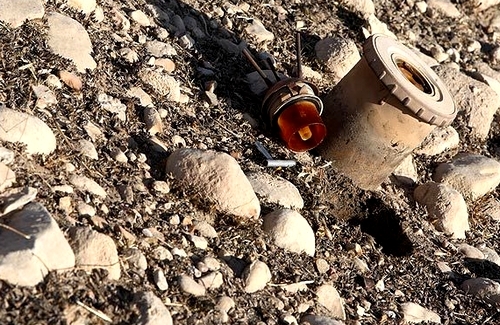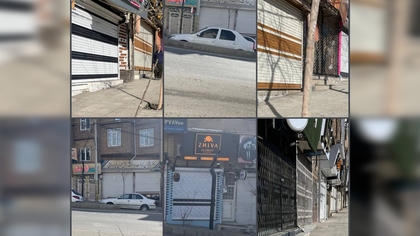Mines in Kurdistan border areas remained intact, a demining expert says
21:13 - 26 August 2018

Kurdistan Press Agency (Kurdpa): A demining expert from Ilam says “The mines laid in the Kurdistan border areas (by the Islamic Republic of Iran) remained intact in order to put obstacle in the way of the Kurdish opposition groups”, he says.
A demining expert, from Ilam, who wanted to remain anonymous, told Kurdpa: “Mine lands are still threatening the lives of Kurdistan’s citizens due to lack of standard clearance as well as plowing the minefields with construction machines.’
With regard to the beginning of laying landmines in Kurdistan, he said it dated back to the early years of the Islamic Republic of Iran. He explained: “After the Iranian Revolution in 1979, following with the clashes between the pro-government military forces and the Kurdish opposition groups as well as the start of Iran-Iraq war which turned Kurdistan into front line, war situation dominated the region. The Iranian military forces started to build military bases, small and big, in strategic places such as around roads, near tunnels, in villages, on top of hills, near bridges, etc. Soon, they had built almost three thousand military bases around which they laid a lot of landmines”.
“As the number of clashes went up, they built those kinds of military bases more and more so that you could find small or big military bases near almost any city and village in Kurdistan. Therefore, the Kurdistan cities’ and villages’ surrounding actually became minefields,” he added.
“The majority of mines were anti-personnel mine-number 4, anti-personnel blast mine-M14 and anti-personnel fragmentation (bouncing) mine-M16 and anti-personnel fragmentation side attack mines-M18”.
“These military bases occupied any places such as pastures, agricultures, wells, rivers or even roads and caused a lot of trouble for people. In building these military bases and laying landmines, different organization and their sabotage engineering unites were involved like the ground military forces, the Islamic Revolutionary Guard Corps, Gendarmery, the Islamic Revolution Committee.” He said.
“As Iran-Iraq war ended, some of the military bases were rapidly evacuated, but they didn’t properly do the clearance of minefield. In some areas, they did it using some innovatively methods. For example, in Saghez, one of the military unites utilized construction machines like excavator and bulldozer to plow the minefields”, he explained.
“The process of evacuation of military bases and the clearance of minefields had faces with some difficulties such as:
- The exact number and places of those military bases were not clear
- Any access to some of the bases was impossible
- Some of the bases didn’t have registered maps of minefields,
- Some of the minefield maps were lost due to the war and merging Gendarmery and the Committee to found Entezami Force
- The clearance was restricted to certain areas within barbed wire,
- Lake of any supervision on the clearance process
- They didn’t destroy the military bases’ facilities
- They didn’t take the barbed wires and the debris away
- They didn’t inform local people about the danger of those minefields
- They didn’t mark the still existed minefields”
“The mentioned elements caused the local population, military forces at those places and minesweepers pay a heavy price. Women, men and children were killed or wounded due to landmine explosion in farms, pastures, touristic resorts or in picking up medical plants”, he confirmed.
“Contrary to the military bases’ minefields, the mines laid in the border areas remained intact in order to put obstacle in the way of the Kurdish opposition groups as well as goods or drug trafficking.”
The Kurdistan’s human rights activists as well as the Kurdish opposition political parties accuse Tehran of increasing the number of landmines instead of being serious to tackle this problem.
A demining expert, from Ilam, who wanted to remain anonymous, told Kurdpa: “Mine lands are still threatening the lives of Kurdistan’s citizens due to lack of standard clearance as well as plowing the minefields with construction machines.’
With regard to the beginning of laying landmines in Kurdistan, he said it dated back to the early years of the Islamic Republic of Iran. He explained: “After the Iranian Revolution in 1979, following with the clashes between the pro-government military forces and the Kurdish opposition groups as well as the start of Iran-Iraq war which turned Kurdistan into front line, war situation dominated the region. The Iranian military forces started to build military bases, small and big, in strategic places such as around roads, near tunnels, in villages, on top of hills, near bridges, etc. Soon, they had built almost three thousand military bases around which they laid a lot of landmines”.
“As the number of clashes went up, they built those kinds of military bases more and more so that you could find small or big military bases near almost any city and village in Kurdistan. Therefore, the Kurdistan cities’ and villages’ surrounding actually became minefields,” he added.
“The majority of mines were anti-personnel mine-number 4, anti-personnel blast mine-M14 and anti-personnel fragmentation (bouncing) mine-M16 and anti-personnel fragmentation side attack mines-M18”.
“These military bases occupied any places such as pastures, agricultures, wells, rivers or even roads and caused a lot of trouble for people. In building these military bases and laying landmines, different organization and their sabotage engineering unites were involved like the ground military forces, the Islamic Revolutionary Guard Corps, Gendarmery, the Islamic Revolution Committee.” He said.
“As Iran-Iraq war ended, some of the military bases were rapidly evacuated, but they didn’t properly do the clearance of minefield. In some areas, they did it using some innovatively methods. For example, in Saghez, one of the military unites utilized construction machines like excavator and bulldozer to plow the minefields”, he explained.
“The process of evacuation of military bases and the clearance of minefields had faces with some difficulties such as:
- The exact number and places of those military bases were not clear
- Any access to some of the bases was impossible
- Some of the bases didn’t have registered maps of minefields,
- Some of the minefield maps were lost due to the war and merging Gendarmery and the Committee to found Entezami Force
- The clearance was restricted to certain areas within barbed wire,
- Lake of any supervision on the clearance process
- They didn’t destroy the military bases’ facilities
- They didn’t take the barbed wires and the debris away
- They didn’t inform local people about the danger of those minefields
- They didn’t mark the still existed minefields”
“The mentioned elements caused the local population, military forces at those places and minesweepers pay a heavy price. Women, men and children were killed or wounded due to landmine explosion in farms, pastures, touristic resorts or in picking up medical plants”, he confirmed.
“Contrary to the military bases’ minefields, the mines laid in the border areas remained intact in order to put obstacle in the way of the Kurdish opposition groups as well as goods or drug trafficking.”
The Kurdistan’s human rights activists as well as the Kurdish opposition political parties accuse Tehran of increasing the number of landmines instead of being serious to tackle this problem.



